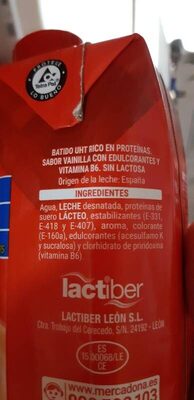Bebida whey proteínas - Hacendado - 330 ml
This product page is not complete. You can help to complete it by editing it and adding more data from the photos we have, or by taking more photos using the app for Android or iPhone/iPad. Thank you!
×
Barcode: 8480000166715 (EAN / EAN-13)
Quantity: 330 ml
Brands: Hacendado
Categories: Beverages, Dairies, Dairy drinks, Artificially sweetened beverages
Labels, certifications, awards: No lactose
Origin of ingredients: Spain
Manufacturing or processing places: León
Traceability code: ES 15.00068/LE CE
Countries where sold: Spain
Matching with your preferences
Environment
Packaging
Transportation
Report a problem
Data sources
Product added on by elcoco
Last edit of product page on by kiliweb.
Product page also edited by ecoscore-impact-estimator, elcoco.c6ef91e23a271a71142bda6a78f581df, hansuk, maylord, musarana, openfoodfacts-contributors, peli309, roboto-app, yuka.WWZndUxyZ0x0dEkzc3ZBYXpCZmx3OUJ6eXBLekFsM3FKOUZBSUE9PQ, yuka.sY2b0xO6T85zoF3NwEKvlmBHCNH7_Q3PGzvWmheA1_m1d7_Hc9Z1yIrQYqo, yuka.sY2b0xO6T85zoF3NwEKvlmJqesTGqzmVaQDTv0fX_86lH5LmY4l_-5PAMqg.










